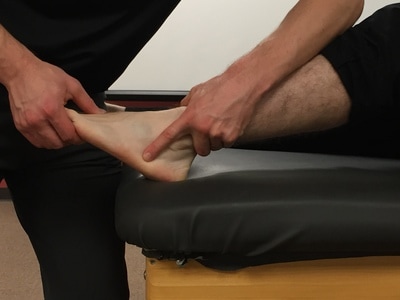- Home
- About Us
- TSPT Academy
- Online Courses
-
Resources
- Newsletter
- Business Minded Sports Physio Podcast
- Day in the Life of a Sports PT
- Residency Corner
-
Special Tests
>
-
Cervical Spine
>
- Alar Ligament Test
- Bakody's Sign
- Cervical Distraction Test
- Cervical Rotation Lateral Flexion Test
- Craniocervical Flexion Test (CCFT)
- Deep Neck Flexor Endurance Test
- Posterior-Anterior Segmental Mobility
- Segmental Mobility
- Sharp-Purser Test
- Spurling's Maneuver
- Transverse Ligament Test
- ULNT - Median
- ULNT - Radial
- ULNT - Ulnar
- Vertebral Artery Test
- Thoracic Spine >
-
Lumbar Spine/Sacroiliac Joint
>
- Active Sit-Up Test
- Alternate Gillet Test
- Crossed Straight Leg Raise Test
- Extensor Endurance Test
- FABER Test
- Fortin's Sign
- Gaenslen Test
- Gillet Test
- Gower's Sign
- Lumbar Quadrant Test
- POSH Test
- Posteroanterior Mobility
- Prone Knee Bend Test
- Prone Instability Test
- Resisted Abduction Test
- Sacral Clearing Test
- Seated Forward Flexion Test
- SIJ Compression/Distraction Test
- Slump Test
- Sphinx Test
- Spine Rotators & Multifidus Test
- Squish Test
- Standing Forward Flexion Test
- Straight Leg Raise Test
- Supine to Long Sit Test
-
Shoulder
>
- Active Compression Test
- Anterior Apprehension
- Biceps Load Test II
- Drop Arm Sign
- External Rotation Lag Sign
- Hawkins-Kennedy Impingement Sign
- Horizontal Adduction Test
- Internal Rotation Lag Sign
- Jobe Test
- Ludington's Test
- Neer Test
- Painful Arc Sign
- Pronated Load Test
- Resisted Supination External Rotation Test
- Speed's Test
- Posterior Apprehension
- Sulcus Sign
- Thoracic Outlet Tests >
- Yergason's Test
- Elbow >
- Wrist/Hand >
- Hip >
- Knee >
- Foot/Ankle >
-
Cervical Spine
>
- I want Financial Freedom
- I want Professional Growth
- I want Clinical Mastery
Impingement Sign
Purpose: To assess for impingement of the talocrural joint.
Test Position: Sitting.
Performing the Test: Grasp the patient's calcaneus with one hand and the forefoot of the patient with a second hand to bring the patient's foot into a position of plantarflexion. The examiner then places his/her thumb over the anterolateral aspect of the ankle and brings the foot into dorsiflexion and eversion. A positive test results when the patient experiences pain with pressure over the anterolateral ankle and when the pain response is greater with the ankle in dorsiflexion and eversion than in plantar flexion.
Diagnostic Accuracy: Sensitivity: .95; Specificity: .88; -LR: .06; +LR: 7.9 .
Importance of Test: The closed packed position of the talocrural joint is full dorsiflexion. During the impingement sign test, the patient is brought into the closed packed position, placing several connective tissues and muscles on passive tension. Additionally, the trochlear surface of the talus is wider anteriorly than posteriorly. When the patient is brought into dorsiflexion, the concave tibiofibular segment of the ankle mortise is brought into increased contact with the talus, creating a wedging (impinging) effect.
Note: these tests should only be performed by a properly trained health care practitioner.
Test Position: Sitting.
Performing the Test: Grasp the patient's calcaneus with one hand and the forefoot of the patient with a second hand to bring the patient's foot into a position of plantarflexion. The examiner then places his/her thumb over the anterolateral aspect of the ankle and brings the foot into dorsiflexion and eversion. A positive test results when the patient experiences pain with pressure over the anterolateral ankle and when the pain response is greater with the ankle in dorsiflexion and eversion than in plantar flexion.
Diagnostic Accuracy: Sensitivity: .95; Specificity: .88; -LR: .06; +LR: 7.9 .
Importance of Test: The closed packed position of the talocrural joint is full dorsiflexion. During the impingement sign test, the patient is brought into the closed packed position, placing several connective tissues and muscles on passive tension. Additionally, the trochlear surface of the talus is wider anteriorly than posteriorly. When the patient is brought into dorsiflexion, the concave tibiofibular segment of the ankle mortise is brought into increased contact with the talus, creating a wedging (impinging) effect.
Note: these tests should only be performed by a properly trained health care practitioner.
References: Flynn , Timothy. Users' Guide to Musculoskeletal Examination. USA: Evidence in Motion, 2008. Print.
Neumann, Donald. Kinesiology of the Musculoskeletal System. 2nd Edition. Mosby Printing Inc. Print.
Copyright © The Student Physical Therapist LLC 2023



